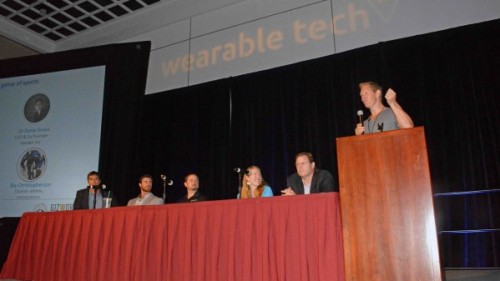by Dot Cannon
“Robots should exude personality.”
“A pair of socks (detects runners’ speed and technique).”
“This phone is also a projector”.
These were just three of many ideas offered at Day 1 of The 2015 Gizworld Wearable Tech and IOT LA Conference, on Monday in the Pasadena Convention Center.
The program started with Sphero Chief Creative Officer Rob Maigret. During his keynote on “The Future of Connected Play”, he showed his audience three recently-developed robots. The missing element in current robotics, Maigret said, was companionship.
“I believe…there is a problem with our programming as human beings,” he said. “At the core (of all of us) there is a little bit of loneliness. Could these robotic companions someday cure the loneliness we all have?”
Panel presentations followed the keynote.

“How do we engage kids’ attention in this world?” moderator Corey Herscu asked his panel on “Biggest Opportunity for Wearable and IoT for Kids”.
“Kids want fun first, and then if they learn something, great,” offered Spiral Toys CEO Mark Meyers.
Later on in the discussion, MakieLab Founder and CEO Alice Taylor voiced an innovative perspective on kids, education and computers.
“Code is how you communicate with machines, and machines are everywhere,” she said. “(Coding) should actually be taught as a language.”
Attendees were an intimate but engaged group, asking questions throughout the day’s discussions.
At noon, everyone took a break. The exhibit floor was open!
How cool is this wearable? First responders could literally consider it a lifesaver.
Gabe Grifoni, CEO and Co-Founder of Rufus Labs, was one of the entrepreneurs displaying a new project. He and his team created the “Rufus Cuff”, a miniaturized tablet to be worn on your wrist!
Across the exhibit floor was Joseph Chiu, Co-Founder of ToyBuilder Labs, displaying his “Idea Printer” 3D printer. Joseph and his wife founded their company, ToyBuilder Labs, to promote the idea of making things. At first, he says, they just sold 3D printing supplies, but now this is one of several printers they sell.
Highlights of the afternoon’s programs included this panel on “How Wearables Will Transform the Game of Sports”.
“They expect 50 billion sensors connected by the year 2020,” commented the group’s moderator, Olympic athlete Sky Christopherson. The panel discussed ways to get athletes to use performance-tracking wearables, and some of the advantages. They agreed that user-friendly devices, that had it right the first time, were the way to go.
“The person just wants the little piece of information that gets them closer to their goal,” said Veristride CEO Stacy Morris Bamberg.
STATS Director of Elite Performance Paul Robbins agreed. “It has to be ready to go,” he said. “With the athlete, he’ll only put it on one time. And if it doesn’t work, he’ll tell all the other athletes.”
The afternoon ended on an intriguing high note. Hyperloop Transportation Technologies CEO Dirk Ahlborn shared his vision for the future, in a closing keynote.
That vision involved connecting cities throughout the United States with a “hyperloop”: a pneumatic tube transport designed to travel at speeds that allow passengers to go from Los Angeles to San Francisco in 36 minutes!
Ahlborn said his group had completed feasibility studies in December. Now, they were set to do a test–by building a five-mile-long hyperloop in Quay Valley, an hour south of Fresno.
“We break ground in 2016, and plan to be done in 2018,” he said.
However, don’t start planning your hyperloop cross-country trip just yet.
“We don’t think the first full-length hyperloop will happen in the U.S.,” Ahlborn said. “Very likely, the next one’s going to be (in) Asia, the Middle East or Africa.”







